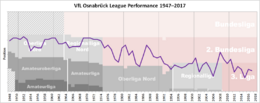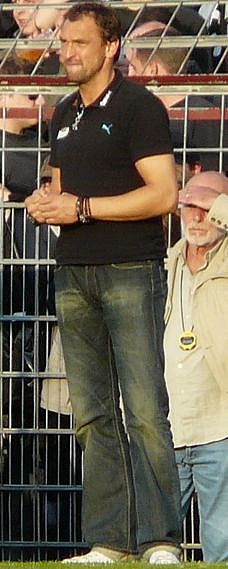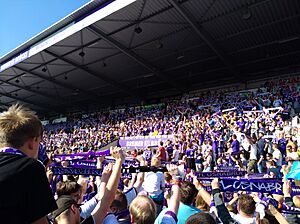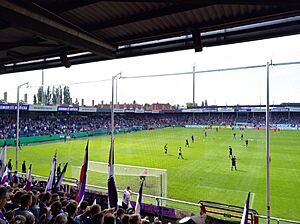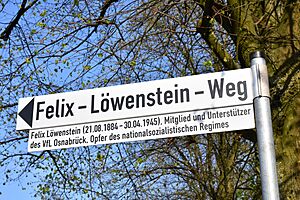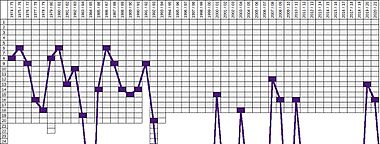VfL Osnabrück facts for kids
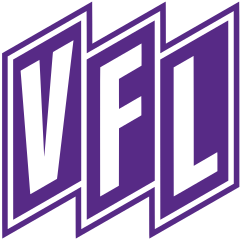 |
||||
| Full name | Verein für Leibesübungen von 1899 e.V. Osnabrück |
|||
|---|---|---|---|---|
| Nickname(s) | die Lila-Weißen (The Purple-Whites) | |||
| Founded | 1899 | |||
| Ground | Stadion an der Bremer Brücke | |||
| Capacity | 15,741 | |||
| Chairman | Holger Elixmann | |||
| Head coach | Timo Schultz | |||
| League | 3. Liga | |||
| 2020–21 | 2. Bundesliga, 16th of 18 (relegated) | |||
|
||||
VfL Osnabrück is a German sports club located in Osnabrück, Lower Saxony. It has teams for basketball, gymnastics, swimming, table tennis, and tennis. However, it is most famous for its football (soccer) team.
The football team currently plays in the 3. Liga. They were recently relegated from the 2. Bundesliga after the 2023-24 season. The team is coached by Timo Schultz.
VfL Osnabrück holds the record for playing the most seasons in the 2. Bundesliga without ever reaching the top German league, the Bundesliga. They are also ranked 10th in the 2. Bundesliga's all-time table.
Contents
Club History
How the Club Started
The club began on April 17, 1899. Three smaller clubs named Antipodia, Germania, and Minerva joined together. They formed a new club called Fußball Club 1899 Osnabrück. In 1920, this group merged with Osnabrücker Ballverein 05. They then played as BV 1899 Osnabrück.
Osnabrücker BV 05 was created in 1905. It was formed when Fußball Club Edelweiß 1902 Osnabrück and Fußball Club Alemannia Osnabrück merged. This club reached the quarterfinals of a regional final in 1910.
The club we know today, Verein für Leibesübungen Osnabrück, was formed in 1924. BV 1899 Osnabrück joined with Spiel- und Sport Osnabrück. Before 1921, Spiel- und Sport Osnabrück was the football part of a gymnastics club.
VfL was officially registered on March 8, 1925. Some members left soon after to start a new team called Sportclub Rapid Osnabrück. This team was inspired by the famous club Rapid Vienna. Rapid rejoined VfL thirteen years later in 1938. The club then adopted the light-purple colors of the returning Rapid players.
After German football leagues were reorganized in 1933, Osnabrück played in the second division. They were promoted to the top league, the Gauliga Niedersachsen, in 1935. They were relegated after one season but returned in 1937. They won their division title in the 1938–39 season. VfL also won the overall division title in 1940. Their wins in 1939 and 1940 allowed VfL to play for the national championship.
Post-War Football and Golden Years
After World War II, the club played as 1. FSV Osnabrück. They changed back to their traditional name, VfL Osnabrück, in 1946. The team played in the Oberliga Nord, which was a top league. They performed well, ranking fourth in the league's history. Only famous clubs like Hamburger SV and Werder Bremen were ahead of them.
In 1963, the Bundesliga was created as Germany's new professional league. VfL Osnabrück did not qualify for it. They were placed in the second division, Regionalliga Nord. VfL never made it to the Bundesliga. However, they had great success in the early Bundesliga years. VfL won the Regionalliga Nord three times in a row from 1969 to 1971. They also finished second in 1972 and 1973. This meant they played in the 'Aufstiegsrunde' five times. This was a playoff where top teams competed for a spot in the Bundesliga. In 1969, they finished second, losing only once. This was their closest chance to reach the Bundesliga.
During this time, VfL Osnabrück also had successful basketball and table tennis teams. Their basketball team even became German champions in 1969.
Becoming 2. Bundesliga Regulars
In 1974, a new national second division was introduced. It was split into North and South groups. Osnabrück played in the 2. Bundesliga Nord. They did not achieve the same success as before. In 1978–79, Osnabrück had a famous 5–4 win against Bayern Munich in the DFB-Pokal cup. Despite this, they finished 18th in the league. They were saved from relegation because two other teams lost their licenses.
The 2. Bundesliga became a single national league in 1981. Osnabrück qualified for the first season in 1981–82. They spent almost the entire decade in the second division. Their best result was finishing sixth in 1986–87. In 1992–93, Osnabrück was relegated to the Oberliga Nord. They won the German amateur football championship in 1995.
The 21st Century
After several years in the Regionalliga Nord, Osnabrück was promoted back to the 2. Bundesliga in June 2000. They won the Regionalliga Nord for the second year in a row. They beat Union Berlin in a playoff, winning on penalties. However, the club was immediately relegated back to the third division. They won promotion again in 2002–03. But the coach left, and the club finished last in the 2. Bundesliga in 2003–04.
Former player Claus-Dieter Wollitz became coach in 2004. In 2006–07, Osnabrück finished second in the league. This secured their promotion. Wollitz helped the team stay in the 2. Bundesliga in 2007–08. They finished 12th, their highest finish since 1988. This game was also the last for Joe Enochs, who played more games for Osnabrück than anyone else.
The next season, the club was relegated in a difficult situation. After losing a playoff, it was found that a player was involved in a match-fixing scandal. This might have affected the outcome. Osnabrück then became known as a 'Fahrstuhlmannschaft', which means a "Yo-yo club". This term describes teams that often move between leagues.
This relegation started a period of eight seasons in the 3. Liga. Claus-Dieter Wollitz returned as coach in 2012. Osnabrück finished third in 2012–13. They qualified for the promotion playoff but lost again.
After some financial struggles, the club returned to its traditional logo in 2017. The stadium name also changed back to Bremer Brücke. In the 2017–18 season, VfL almost dropped to the fourth division. Former player Daniel Thioune took over as coach.
In his first full season, Thioune's Osnabrück won the 3. Liga title. They were promoted on the club's 120th anniversary. Back in the 2. Bundesliga, Osnabrück did well. They beat big clubs like Hamburger SV and VfB Stuttgart. They finished 13th.
Thioune left in 2020. In the 2020–21 season, the club had two coaches. Osnabrück again finished in the relegation playoff spot. They lost and returned to the 3. Liga.
Club Achievements
- Gauliga Niedersachsen (Top League)
- Champions: 1939, 1940
- Regionalliga Nord (Second League)
- Champions: 1969, 1970, 1971
- Runners-up: 1972, 1973
- Oberliga Nord (Third League)
- Champions: 1985
- Regionalliga Nord (Third League)
- Champions: 1999, 2000
- Runners-up: 1995, 2003
- 3. Liga (Third League)
- Champions: 2009–10, 2018–19
- German amateur football championship
- Champions: 1995
- Lower Saxony Cup (Regional Cup)
- Winners: 2005, 2013, 2015, 2017, 2023
Current Players
Team Roster
|
|
Players on Loan
|
|
Home Stadium
The club plays its home games at the Stadion an der Bremer Brücke. It is often simply called the Bremer Brücke. The stadium has had other names in the past. It returned to its traditional name in 2017.
The stadium was built in 1931 by Rapid Osnabrück. This team later rejoined VfL. It has been VfL Osnabrück's home ground ever since. The stadium used to hold over 30,000 fans. Now, it can hold just over 16,000 people.
Fans really love the stadium. It was voted the most exciting stadium in the 3. Liga in an online poll.
Club Colors and Fans
The club's main colors are purple and white. The team is often called die Lila-Weißen, which means "The Purple-Whites". Their home uniforms are usually mostly purple.
For their 120th anniversary in 2019, the club wore a special black uniform. This was inspired by the club's original colors. In the 2019–20 season, their home shirt combined purple and black.
The club actively speaks out against racism. In 2018, they wore a special uniform with a message against hate. In 2022, they wore a uniform with the message "Build Bridges!".
The "VfL Bündnis" is a group that includes the VfL Museum and fan groups. In 2019, they won an award from the DFB. This was for their work honoring Felix Löwenstein. He was a Jewish club member who was killed by the Nazis in 1945. The VfL Museum also helped rename a road next to the stadium to Felix-Löwenstein-Weg. This happened as part of the club's 120th anniversary.
VfL Osnabrück's main rivals are SC Preußen Münster.
Recent Seasons Performance
This table shows how the club has performed in recent seasons:
| Year | Division | Tier | Position |
|---|---|---|---|
| 1999–2000 | Regionalliga Nord | III | 1st ↑ |
| 2000–01 | 2. Bundesliga | II | 15th ↓ |
| 2001–02 | Regionalliga Nord | III | 7th |
| 2002–03 | Regionalliga Nord | 2nd ↑ | |
| 2003–04 | 2. Bundesliga | II | 18th ↓ |
| 2004–05 | Regionalliga Nord | III | 4th |
| 2005–06 | Regionalliga Nord | 10th | |
| 2006–07 | Regionalliga Nord | 2nd ↑ | |
| 2007–08 | 2. Bundesliga | II | 12th |
| 2008–09 | 2. Bundesliga | 16th ↓ | |
| 2009–10 | 3. Liga | III | 1st ↑ |
| 2010–11 | 2. Bundesliga | II | 16th ↓ |
| 2011–12 | 3. Liga | III | 7th |
| 2012–13 | 3. Liga | 3rd | |
| 2013–14 | 3. Liga | 5th | |
| 2014–15 | 3. Liga | 11th | |
| 2015–16 | 3. Liga | 5th | |
| 2016–17 | 3. Liga | 6th | |
| 2017–18 | 3. Liga | 17th | |
| 2018–19 | 3. Liga | 1st ↑ | |
| 2019–20 | 2. Bundesliga | II | 13th |
| 2020–21 | 2. Bundesliga | 16th ↓ | |
| 2021–22 | 3. Liga | III | 6th |
| 2022–23 | 3. Liga | 3rd ↑ | |
| 2023–24 | 2. Bundesliga | II | 18th ↓ |
| 2024–25 | 3. Liga | III | 14th |
| 2025–26 | 3. Liga |
- Key
| ↑ Promoted | ↓ Relegated |
See also
 In Spanish: VfL Osnabrück para niños
In Spanish: VfL Osnabrück para niños


